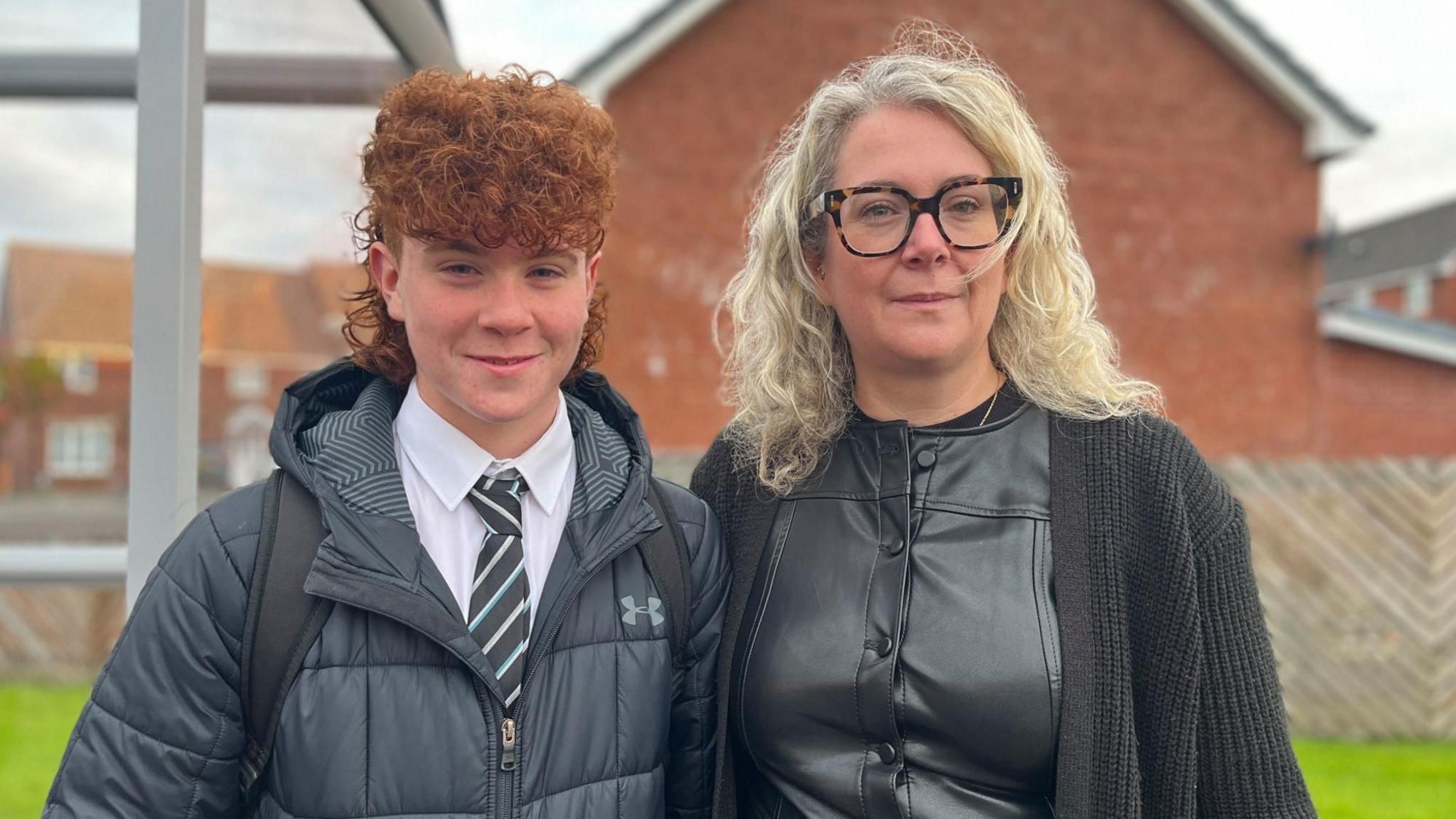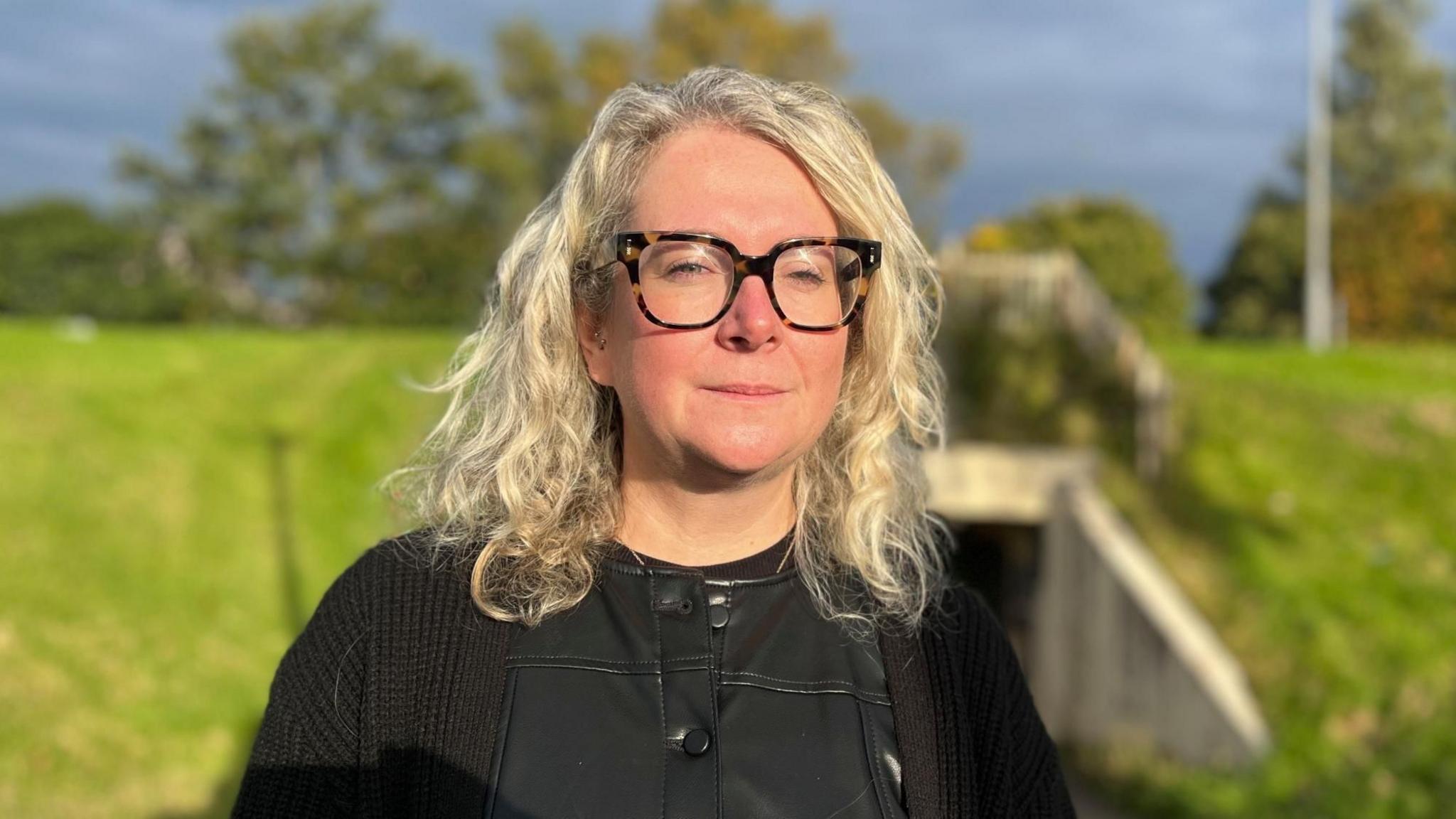School bus provision is a 'massive muddle' say parents

Heather's son Elliot is no longer eligible for a free school bus
- Published
A growing number of councils are tightening their policies on free school bus provision but parents' groups claim it is leaving a "massive muddle", with some pupils struggling to get to school.
Fourteen-year-old Elliot used to rely on the free school bus to get to his school in East Kilbride but in August the rules changed, leaving him and his friends ineligible.
Secondary pupils in South Lanarkshire had been given free transport if they lived more than two miles from school but that changed to three miles.
With no other public transport available, Elliott now has to walk an hour each way to school on a "safe route" that includes an underpass, back lanes and a crossing over a dual carriageway.
South Lanarkshire Council says the legal responsibility for children to get to school lies with parents and that their previous policy was more generous than Scottish government guidelines.

Heather says she feels the council-designated safe route is dangerous
Elliot's mum Heather says she feels let down by the council and that she's not the only one.
"This area is full of lots of young families who chose to move here because it was a good place to live with good resources and there were buses available for the children to go to school," she says.
"We were promised when the schools amalgamated that no child would be without a bus where it was required.
"There is no local suitable public transport option for these children."
Heather says she feels the council-designated safe route is dangerous, partly because there are busy roads with no crossing patrollers.
"It's not safe," she says.
"It's unacceptable the length of time it takes, asking children to walk through unlit or poorly lit areas, areas where we know there has been crime, areas where there's not a huge amount of visibility from other people, that's not safe at all.
"The council need to look elsewhere - there's lots of money getting spent on other things. Maybe the priorities need to be reassessed."

Barbra Clegg says her daughter is scared of making the journey in the dark
Barbra Clegg says her daughter, who is in third year, and her friends, are scared at having to make the 2.8 mile journey home when it's dark in winter.
"I'm really worried about it," she says.
"At the moment it's light but Tuesday and Thursday they finish at 4 o'clock so it's going to be dark when they walk home in the winter.
"They're terrified about walking home on their own through these lanes and underpasses."
Statutory walking distances
The 1980 Education Act sets out that councils make arrangements as they "consider necessary" for the provision of school transport.
It also sets "statutory walking distances" of two miles for children under eight and three miles for those over.
Connect - the parent council organisation in Scotland - says council policies have increasingly been reduced to the legal minimum and that free school transport now varies a lot between local authorities.
It is calling for clear, statutory guidance from the Scottish government.
In recent years, councils such as Aberdeen, East Ayrshire and North Lanarkshire have all reduced eligibility for free school bus services.
Moray council announced last month that it intended to restrict its criteria from August 2026.
In minutes from a council meeting, it said that moving to three miles brought Moray under the statutory guidelines "while offering the opportunity to incur some small savings through reduction in provision".
Lydia McDonald, from Connect, said: "It's a massive muddle.
"Some go with a kind of two-mile for primary school, three-mile for secondary school rule - and some go for completely different rules that don't have any consistency with the guidelines.
"We do need school buses. There is a real issue with buses being available and it's an issue for urban populations as well as rural populations."
Ms McDonald said two-thirds of parents her group spoke to said there was not an available public bus route to take their child to school.
School safety
She says the main concern from parents' groups is that the safe walking routes are not being assessed sensibly by local authorities.
"There is an issue where walking routes for high school children are being assessed as only safe if accompanied, which is not sensible," she says.
"It goes against the Scottish government's own guidelines for school safety".
Connect is concerned that the growing trend means parents without cars or who work shifts or irregular hours find changes in bus policies especially difficult to manage.
A spokesperson for South Lanarkshire Council said: "The legal responsibility for ensuring that children go to school, and do so safely, lies with their parents rather than with the council.
"Nevertheless, the council does work to assist with this by determining, where appropriate, safe walking routes to schools to allow parents to make the most informed decisions on how they wish their children to travel.
"Where parents have concerns with a safe walking route, they can ask us to review the route, and we will always endeavour to do so."
A Scottish government spokesperson said local authorities were responsible for decisions on school transport - and in ensuring that roads and pavements are safe.
They said guidance makes clear that councils should make decisions on a case-by-case basis, taking families circumstances and reasonable adjustments into account.